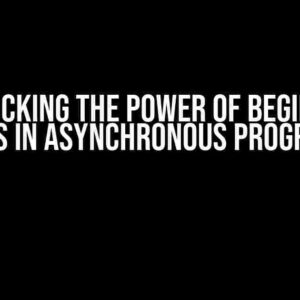As a developer working with Windows Presentation Foundation (WPF), you might have wondered what happens to your application’s objects when it exits. Do they linger in memory, waiting to be garbage collected, or do they get destroyed immediately? In this article, we’ll dive into the world of WPF and explore what happens to objects when the application exits.
What is Garbage Collection?
Before we dive into WPF specifics, let’s quickly cover what garbage collection is. Garbage collection is a mechanism used by the .NET runtime to automatically manage memory and eliminate memory leaks. It works by identifying objects in memory that are no longer referenced or needed, and then freeing up that memory for future use. This process is called garbage collection.
How Does Garbage Collection Work in WPF?
In WPF, garbage collection is a bit more complex than in traditional .NET applications. This is because WPF uses a concept called “logical trees” to manage its visual elements. A logical tree is a hierarchical structure that represents the visual elements of your application, such as buttons, labels, and text boxes.
When you exit a WPF application, the logical tree is not automatically destroyed. Instead, it’s up to the garbage collector to identify which objects are no longer referenced and free up their memory. This process can take some time, depending on the complexity of your application and the amount of memory in use.
What Happens to Objects When the Application Exits?
Now that we’ve covered garbage collection in WPF, let’s explore what happens to objects when the application exits. In general, objects in WPF can be classified into three categories:
- Rooted objects: These are objects that are referenced by the logical tree or by other objects that are still in use. Examples include window instances, user controls, and data contexts.
- Unrooted objects: These are objects that are no longer referenced by the logical tree or by other objects. Examples include event handlers, command bindings, and data templates.
- Disposed objects: These are objects that have been explicitly disposed of using the
IDisposableinterface. Examples include bitmap images, file streams, and database connections.
When the application exits, rooted objects are not immediately destroyed. Instead, they remain in memory until the garbage collector runs and identifies them as no longer referenced. Unrooted objects, on the other hand, are eligible for garbage collection as soon as the application exits. Disposed objects, as the name suggests, are explicitly released from memory using the IDisposable interface.
Why Does WPF Not Run GC and Destroy Objects on Application Exit?
So, why doesn’t WPF run the garbage collector and destroy objects when the application exits? There are a few reasons for this:
- Performance**: Running the garbage collector can be an expensive operation, especially for large and complex applications. By delaying garbage collection until the application exits, WPF can improve startup performance and responsiveness.
- Resource management**: WPF applications often use system resources such as file handles, window handles, and database connections. These resources need to be released explicitly using the
IDisposableinterface. Running the garbage collector on application exit would not release these resources, leading to potential system crashes and errors. - Design philosophy**: WPF is designed to provide a high-level abstraction over the underlying Windows API. By not running the garbage collector on application exit, WPF can provide a more consistent and reliable programming model, where objects are explicitly created and destroyed by the developer.
Best Practices for Object Lifetime Management in WPF
Given that WPF does not run the garbage collector and destroy objects on application exit, it’s up to the developer to ensure that objects are properly managed and released. Here are some best practices to follow:
| Best Practice | Description |
|---|---|
Use the IDisposable interface |
Implement the IDisposable interface on objects that use system resources, and explicitly release these resources using the Dispose() method. |
| Use weak references | Use weak references to prevent objects from being rooted, allowing them to be garbage collected more easily. |
| Avoid circular references | Avoid creating circular references between objects, which can prevent them from being garbage collected. |
| Use a memory profiler | Use a memory profiler to identify memory leaks and optimize object lifetime management in your application. |
Conclusion
In conclusion, WPF does not run the garbage collector and destroy objects on application exit. Instead, it’s up to the developer to ensure that objects are properly managed and released using best practices such as implementing the IDisposable interface, using weak references, avoiding circular references, and using a memory profiler. By following these guidelines, you can write more efficient and reliable WPF applications that take advantage of the .NET runtime’s garbage collection mechanism.
// Example implementation of the IDisposable interface
public class MyBitmap : IDisposable
{
private BitmapImage _image;
public MyBitmap(BitmapImage image)
{
_image = image;
}
public void Dispose()
{
_image.Dispose();
}
}
Remember, proper object lifetime management is crucial for building efficient and scalable WPF applications. By understanding how WPF manages objects and following best practices, you can write applications that are both responsive and reliable.
Frequently Asked Question
Get your WPF application exit concerns resolved!
Q1: Does WPF really not run GC and destroy objects on application exit?
Actually, WPF does run the Garbage Collector (GC) and destroys objects when the application exits. The GC is responsible for reclaiming the memory occupied by objects no longer in use, and it does its job diligently when the application shuts down.
Q2: But I’ve noticed that sometimes objects remain in memory even after the application closes. What’s going on?
That’s a great observation! While the GC does its best to clean up, there might be scenarios where objects persist in memory due to various reasons like event handlers, static references, or even third-party libraries holding onto objects. These can prevent the GC from collecting them, making it seem like objects aren’t being destroyed.
Q3: How can I ensure that my WPF application releases all objects and memory when it exits?
To ensure a clean exit, make sure to properly dispose of any disposable objects, remove event handlers, and avoid static references. You can also use the `GC.Collect()` method to force the Garbage Collector to run, but be cautious not to overuse it. Additionally, consider using profiling tools to identify and address any memory leaks.
Q4: Are there any specific WPF components that might cause issues with object destruction?
Yes, some WPF components can make object destruction more challenging. For example, the `Storyboard` class can hold onto objects due to its event handlers, and the `BitmapImage` class can keep large images in memory. Be mindful of these components and ensure you’re properly disposing of them when they’re no longer needed.
Q5: Can I rely on the `Finalize` method to ensure objects are destroyed?
No, it’s not recommended to rely solely on the `Finalize` method for object destruction. While it can be used to release unmanaged resources, it’s not a guarantee that objects will be collected immediately. Instead, focus on implementing proper disposal and garbage collection techniques to ensure your application exits cleanly.



